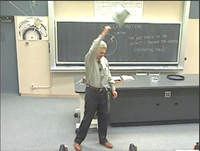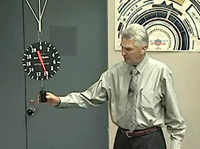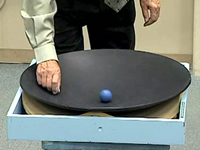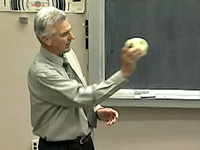
Gravity, Circular Motion, and Satellites
Circular Motion
Different objects are set into circular motion.

Click the image to watch the video
- Large ball on the end of a rope
- Water bucket
- Fish bowl
- Ring
- Steel ball
- Triangle, square, hexagon, and ring
In this movie, uniform circular motion (i.e. circular motion at constant speed) is assumed for simplicity.
Gravity and Weight
A weight hanging from a hanging scale is accelerated upward and then downward.

Click the image to watch the video
- A scale calibrated in newtons and hanging from a ceiling support
- A 1-kg weight
A 1-kg weight is suspended from a spring scale which is calibrated in newtons. As the apparatus is accelerated, the scale measures an apparent weight that depends on the magnitude and direction of the acceleration. With an upward acceleration, the scale reads an apparent weight which is greater than the true weight, and with a downward acceleration, the scale reads an apparent weight which is less than the true weight. With the apparatus falling freely for a short time, the scale registers an apparent weight of zero.
Satellite Motion
Objects are set into motions similar to orbiting satellites.

Click the image to watch the video
- Gravity well
- Small steel ball, larger rubber ball
- Fish bowl
- Bowling ball pendulum
Various objects are set into circular motion to simulate satellite motion. In each case, the net force toward the center (centripetal force) is emphasized and is compared to the force of gravity acting on an actual satellite.
Ball in Orbit
A ball is thrown horizontally several times at successively higher speeds.

Click the image to watch the video
- Rubber ball
In a succession of experiments, a ball is first dropped straight down and subsequently thrown with increasing speeds to illustrate the relationship between projectile motion and satellite motion. It is shown that a satellite may be thought of as a projectile with a sufficient horizontal velocity to fall vertically at a rate that follows the curvature of the earth.